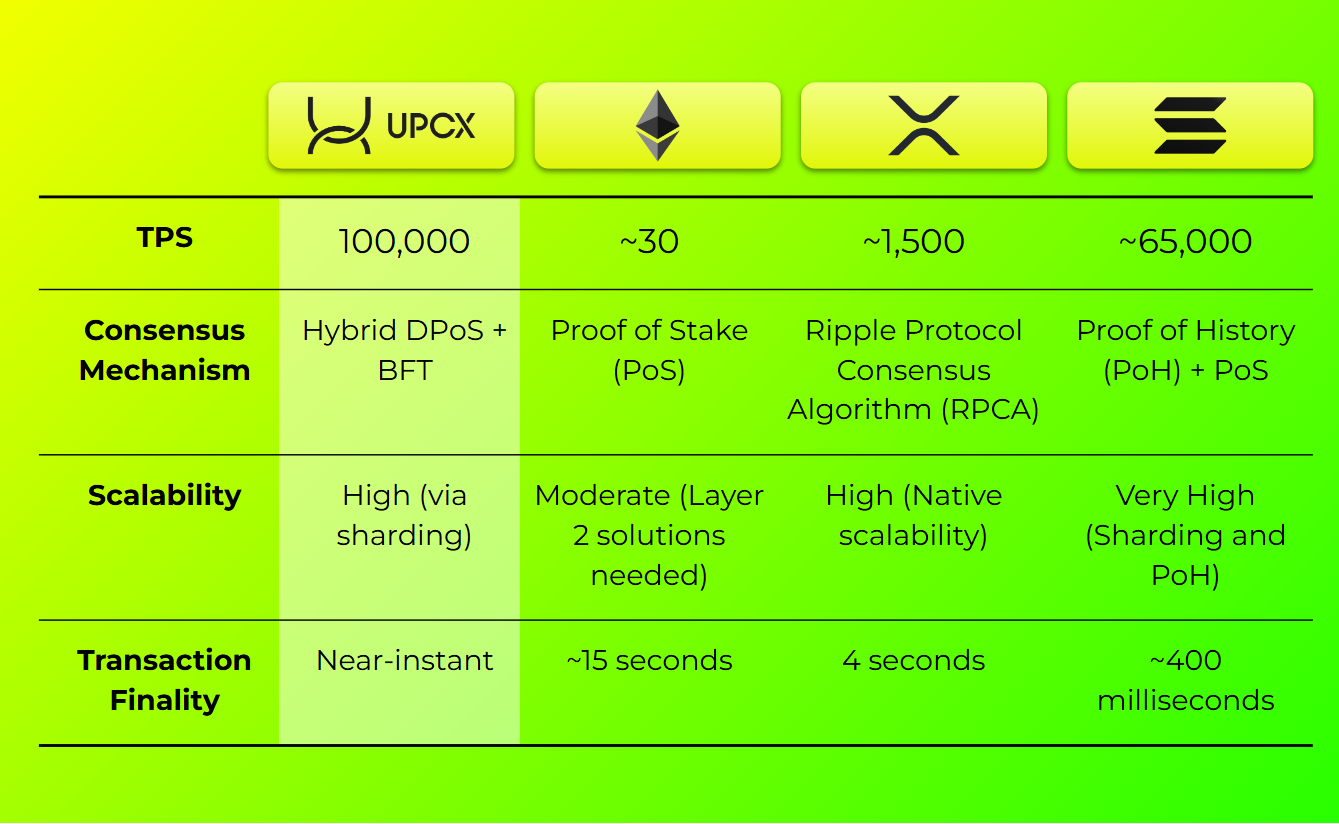In the crowded and rapidly evolving blockchain sector, UPCX is a pioneer in cryptocurrency payment systems. Its recent strategic partnership with PAYCLE and the Japan Society of Next Generation Sensor Technology, along with significant technological advancements, have further solidified UPCX’s leadership in the industry. Focusing on key areas such as unparalleled transaction speed, innovative consensus mechanisms, and user-centric design, UPCX has surpassed many emerging competitors.
Moreover, the UPCX mainnet has recently been launched, initiating its high-speed blockchain network capable of handling up to 100,000 transactions per second (TPS) with potential for further scalability. This marks an important milestone in the platform’s development. Future updates to UPCX will provide additional DeFi tools and more features to enhance the UPCX experience. Some features, such as cross-chain integration and currency exchange, are still under internal discussion, with UPCX’s legal counsel ensuring compliance in different regions. These updates highlight UPCX’s commitment to continuous improvement and adaptability within the dynamic blockchain ecosystem.
This article delves into three high-impact areas where UPCX demonstrates its strengths: transaction speed and scalability, innovative consensus mechanisms, and enhanced user experience.
1.Unmatched Transaction Speed and Scalability
Technical Overview
One of UPCX’s standout features is its ability to handle an impressive 100,000 transactions per second (TPS), with potential for further scalability.This is achieved through a combination of advanced technologies:
l Hybrid Consensus Algorithm: UPCX employs a blend of Delegated Proof of Stake (DPoS) and Byzantine Fault Tolerance (BFT). This hybrid approach optimizes both speed and security, enabling rapid transaction processing without sacrificing the network’s integrity.
l Sharding: By dividing the blockchain into smaller, interconnected shards, UPCX allows multiple transactions to be processed in parallel. Each shard handles a subset of transactions, significantly boosting overall throughput and ensuring the network remains efficient even as it scales.
Comparison with Competitors

While Ethereum struggles with scalability, often requiring Layer 2 solutions to handle higher transaction volumes, UPCX’s native architecture eliminates this bottleneck. Compared to Ripple, which offers high TPS but primarily focuses on banking and institutional transfers, UPCX provides a versatile platform suitable for a broader range of applications, including IoT and smart city integrations.
2.Innovative Consensus Mechanism
Hybrid DPoS + BFT Explained
UPCX’s consensus mechanism is a hybrid of Delegated Proof of Stake (DPoS) and Byzantine Fault Tolerance (BFT):
l Delegated Proof of Stake (DPoS): In this system, a limited number of nodes (Witnesses) are elected by token holders to validate transactions and produce new blocks. This reduces the number of nodes involved in consensus, speeding up the process.
l Byzantine Fault Tolerance (BFT): BFT ensures that the network can achieve consensus even if some of the Witnesses act maliciously or fail. By requiring a majority agreement among Witnesses, BFT adds a layer of security and reliability to the system.
Advantages Over Traditional Mechanisms
l Speed: Traditional Proof of Work (PoW) systems, like Bitcoin, are notoriously slow and energy-intensive. PoS systems offer improvements but still lag behind UPCX’s hybrid approach.
l Security: Pure DPoS systems can be vulnerable to collusion among Witnesses. The addition of BFT mitigates this risk, ensuring that even if some Witnesses are compromised, the network remains secure.
l Energy Efficiency: Unlike PoW, which requires massive computational power, UPCX’s hybrid consensus is far more energy-efficient, aligning with sustainable blockchain initiatives.
Comparison with Solana’s PoH + PoS
Solana utilizes Proof of History (PoH) combined with PoS to achieve high TPS. While both systems aim for speed and scalability, UPCX’s hybrid DPoS + BFT offers enhanced security through BFT, which Solana’s PoH does not inherently provide. This makes UPCX not only fast but also resilient against certain types of attacks that could threaten network integrity.
3.Enhanced User Experience
Named Accounts vs. Traditional Blockchain Addresses
One of the biggest hurdles in blockchain adoption is the complexity of managing long, alphanumeric wallet addresses. UPCX addresses this by introducingNamed Accounts, allowing users to assign human-readable names to their wallet addresses (myupcx).
l Ease of Use: Forget memorizing or copying lengthy strings; simply use a name that’s easy to remember and share.
l Error Reduction: Minimizes the risk of sending funds to incorrect addresses due to typographical errors.
Super App Functionality
UPCX isn’t just a payment system; it’s asuper appthat integrates a multitude of daily services:
l Comprehensive Services: Users can handle reservations, orders, messaging, asset management, and investments within a single application.
l Offline Payments: UPCX’s mobile wallet supports offline transactions, ensuring payments can be made even without internet connectivity. This is particularly useful in areas with unreliable internet access or during network outages.
l Tap to Pay with NFC: Leveraging Near-Field Communication (NFC) technology, UPCX enables seamless contactless payments, enhancing convenience in retail and other point-of-sale environments.

Comparison with Traditional Payment Systems and Other CryptosWhile WeChat Pay offers extensive integrated services, its reliance on a centralized platform contrasts with UPCX’s decentralized approach. Traditional crypto wallets like Coinbase and Trust Wallet provide security and simplicity but lack the expansive service integration and user-friendly features that UPCX’s super app offers. This positions UPCX as a versatile and user-centric alternative in both the conventional and crypto payment ecosystems.
Conclusion
UPCX sets itself apart in the blockchain payment arena through its exceptional transaction speed, innovative consensus mechanisms, and a focus on enhancing user experience. Strategic partnerships, such as the collaboration with PAYCLE INC. and the Japan Society of Next Generation Sensor Technology, further amplify UPCX’s capabilities, integrating advanced sensor technologies with high-speed blockchain payments to drive innovation in IoT and smart cities.
By addressing critical challenges such as scalability, security, and usability, UPCX not only meets but exceeds the demands of modern financial systems. The recentUPCX mainnet launchand ongoing developments in DeFi tools, cross-chain integration, and regulatory compliance highlight UPCX’s commitment to continuous improvement and adaptability. As strategic partnerships emerge and the platform continues to evolve, UPCX is well-positioned to lead the next generation of blockchain-based payment solutions, offering a comprehensive and secure ecosystem for users and developers alike.
